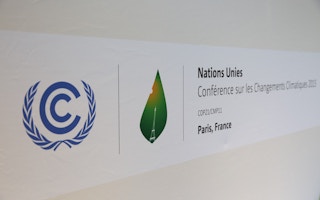The gathering of 190 nations in Paris for the UN climate change summit – widely known as COP21 – may already have averted the most catastrophic predictions of climate change, but only if those nations that have pledged to reduce carbon emissions keep their pledges.
And a new study warns that containing global warming to within a worldwide average of 2°C above the pre-industrial level is possible only if nations go beyond their promises and step up the momentum for change.
The calculations that confront the assembly of nations in Paris for the next two weeks are simple enough: if global economies exploit fossil fuels under a “business as usual” scenario and dump ever greater quantities of carbon dioxide in the atmosphere, then by 2100 global average temperatures will have risen by 4°C or more, and sea levels by a metre − with unimaginable consequences for the world’s poorest people.
Dangerously high
That already seems unlikely. European Union research shows that the targets set so far by the 155 nations that account for 90 per cent of greenhouse gas emissions would restrict global warming to about 3°C above the average for most of human history.
But this is still considered dangerously high. In the last century, average global temperatures have risen, along with carbon dioxide levels, by 1°C already. And even 2°C is not considered a “safe” limit.
Researchers from the US and Austria report in Science journal that they looked at the Intended Nationally Determined Contributions (INDCs) announced so far – which extend only as far as 2025 or 2030 – to see what these would achieve.
The news is encouraging: the INDCs and any future abatement do introduce a chance of meeting the 2°C target, and greatly reduce the risk of a warming that exceeds 4°C. But everything depends on what happens after 2030. So the Paris meeting still has a lot to achieve.
“It’s not just about 2 degrees,” said Gokul Iyer, research associate at the Global Change Research Institute in the US. “It is also important to understand what INDCs imply for the worst levels of climate change.”
The lead author of the report, Allen Fawcett, senior economist at the US Environmental Protection Agency, put the same case another way. “We wanted to know how the commitments would play out from a risk management perspective,” he said. “We analysed not only what the commitments would achieve over the next 10 to 15 years, but also how they might lay a foundation for the future.”
Clear steps
And Joeri Rogelj, research scholar on the energy programme at the International Institute for Applied Systems Analysis in Austria, said: “If we consider Paris the finish line, we will fail to protect our climate. It needs to be the starting point for further action. Clear steps that show how emissions can be further reduced over time are critical for a lasting legacy of Paris.”
Much the same reasoning was outlined by Christiana Figueres, executive secretary of the UN Framework Convention on Climate Change, when she addressed journalists in London recently. She too sees Paris as a process that could define a pathway towards a 2°C limit.
“I have never ever said we would get to 2°C in Paris,” she stressed, “It truly denotes a total misunderstanding of what is being done here. No, we will not get to two degrees.”
But she believes the summit presents an opportunity to create a pathway to a more stable climate, with checkpoints along the way.
She said: “Are we on that pathway now? No. We will be on a pathway to under 3°C. Everybody will agree that it is a sizeable dent. It is not success yet, it is definitely not success. We are on our way.”














